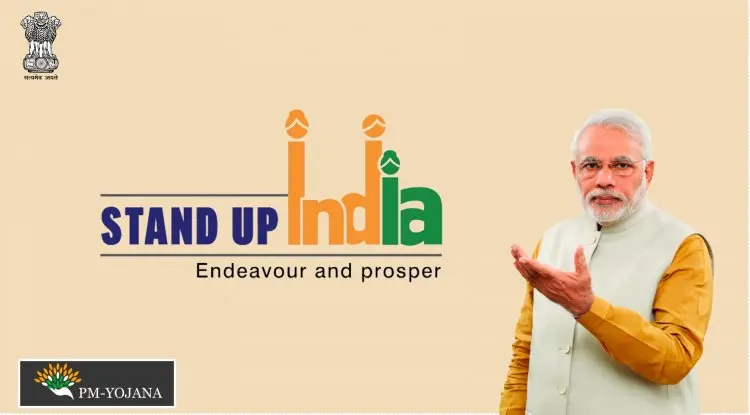Stand Up India Scheme
The Stand up India scheme aims at promoting entrepreneurship among women and scheduled castes and tribes.

Stand Up India Scheme
The Stand up India scheme aims at promoting entrepreneurship among women and scheduled castes and tribes.
The Stand Up India scheme aims at providing people belonging to the scheduled caste or scheduled tribe or women of the country a loan between Rs.10 lakhs to Rs.1 crore, based on their requirement. The aim is to promote entrepreneurship among them. The topic, ‘Stand Up India Scheme’ comes under Indian Polity Syllabus of the IAS Exam and this article will provide you relevant facts about it.
Under the scheme, 1.25 lakh bank branches would each be expected to lend money every year to at least one Dalit or tribal entrepreneur and one woman entrepreneur in their service area.
Who Can Benefit?
The government has been offering a wide range of schemes and programmes to support the citizens of India to bring in new businesses onboard. One such scheme is the Stand-Up India scheme that focuses on strengthening the minorities, such as scheduled castes, scheduled tribes, and women. Do not misunderstand the Stand-Up India scheme with the Startup India scheme. They are two different schemes focussing on different classes of aspirants.
What is the purpose of Stand-Up India scheme?
The objective of the Stand-Up India scheme is to provide financing for Scheduled Caste (SC), Scheduled Tribe (ST), and women entrepreneurs to realise their business ideas. Under the plan, bank loans ranging from Rs.10 lakh to Rs.1 crore can be obtained. They are mostly first-time ventures which may cover up to 75% of the total project cost and require the entrepreneur to commit to at least 10% of the value.
Initially, it was outlined that at least one SC or ST borrower and at least one woman borrower gets the benefit of the scheme per bank branch to set up a greenfield enterprise in manufacturing, services, or trading sector. Enterprises can also avail the benefits of the scheme given that they satisfy the eligibility criteria.
Features and benefits of the scheme
- Nature: The Stand-Up India scheme is a composite loan that is inclusive of term loan and working capital loan.
- Loan Amount: The scheme will cover up to 75% of the project cost.
- Interest Rate: The scheme assures the lowest applicable interest rate of the bank for that category that is well within (base rate * MCLR + 3% + tenor premium).
- Security: Besides the primary security, you can secure the loan with collateral or guarantee of the Credit Guarantee Fund Scheme for Stand-Up India Loans (CGFSIL). The lender takes a call on this.
- Repayment Period: The loan can be repaid over seven years. Also, the scheme offers a moratorium period of up to 18 months.
- Modes of Disbursement: For a loan amount of up to Rs.10 lakh, the sum will be sanctioned by way of overdraft. A RuPay debit card will be issued to access the funds conveniently. For a loan amount above Rs.10 lakh, the sum will be sanctioned in the form of the cash credit limit.
Eligibility criteria
- Only SC/ST individuals and women entrepreneurs can get the benefits of the scheme.
- The applicant must be aged above 18 years.
- Only greenfield projects can apply for the loan scheme.
- Non-individuals, such as existing firms and businesses, can also apply for the scheme.
- 51% of the shareholding and controlling stakes of the firm must be held by either SC/ST and/or women entrepreneurs.
- The borrower should not have defaulted at any bank or financial institution.
Whom should you contact?
You can approach one of the three potential points of contacts to know more about the scheme:
- At the bank branch.
- SIDBI’s Stand-Up India portal, www.standupmitra.in.
- Lead District Manager (LDM).
How to apply for the scheme and avail benefits?
Step 1: Visit the Stand-Up India portal at www.standupmitra.in to understand the scheme details better.
Step 2: Click on the ‘Register’ button and answer a set of questions prompted.
Step 3: Based on your response, you will be categorised either as Trainee Borrower or Ready Borrower.
Step 4: Feedback will be given regarding the eligibility of the applicant for the loan.
Step 5: The applicant can then register and login to the portal.
Step 6: Upon logging in successfully, a dashboard will be displayed to the applicant to proceed with further actions.
What questions can you expect for registering?
The applicant will have to answer the following questions at the time of registering on the portal:
- Location of the borrower.
- Category, as in SC, ST, or woman.
- Type of business planned.
- Location of business set up.
- Assistance required to prepare a project plan.
- Technical and Financial skills/training required.
- Current bank account details.
- Own investment amount for the project.
- Whether help is required to raise the margin amount.
- Experience in business management.
What does a ‘Trainee Borrower’ and ‘Ready Borrower’ mean?
Based on the response and details you provide for the set of questions mentioned above, an applicant will be categorised as Trainee Borrower or Ready Borrower.
Trainee Borrower: If you specify that you need support to raise margin money, you will be categorised as a Trainee Borrower on the portal. It will connect the applicant to the Lead District Manager (LDM) of the concerned district of the applicant and the relevant office of NABARD/SIDBI. The concerned officers will then arrange for support as given below:
- Financial training through Financial Literacy Centres (FLCs).
- Skilling through Vocational Training Centres and others.
- Electronic data processing at MSME DIs, District Industries Centres, and Rural Self Employment Training Institutes.
- Work sheds through District Industries Centres.
- Margin money through State Khadi & Village Industries Board, Women’s Development Corporation, State SC Finance Corporation, and others.
- Mentoring support from renowned entrepreneurs through Women Entrepreneur Associations, Trade Bodies, and other NGOs.
- Utility connections through utility provider offices.
Ready Borrower: If you specify that you do not need any support to obtain the marginal money, you will be categorised as a Ready Borrower on the portal. Also, the portal will start processing your application for a loan at the bank selected. An application number will be generated, and your details will be shared with the bank, LDM, and relevant office of NABARD/SIDBI. You can track the progress of your application on the portal with your application number.
Frequently Asked Questions (FAQs)
Can I get the benefits of any other scheme along with the Stand-Up India scheme?
You can get the benefits of any other scheme along with the Stand-Up India scheme. However, the possibility of receiving financial aid of up to 75% of the total project cost will not apply if you happen to receive convergence support from any other schemes beyond 25% of the total project cost.
What is the margin money requirement for the scheme?
Though you happen to arrange up to 25% of the project cost from state/central schemes or subsidies in addition to the Stand-Up India contributions, you are required to bring in a minimum of 10% of the project cost on your own. The scheme involves margin money of 10% from your pocket to gain the benefits of the scheme.
What is a greenfield project?
A greenfield enterprise is one where new infrastructure will be built on unused land, i.e. no demolition or remodelling of an existing structure will be involved.
Can I avail the support from the available sources after availing the loan?
You can avail the support at any time, even after the loan is sanctioned. Get in touch with the Stand-Up Connect Centres to access the services.







